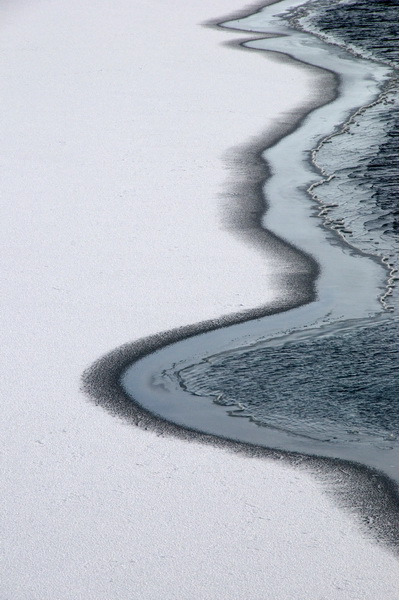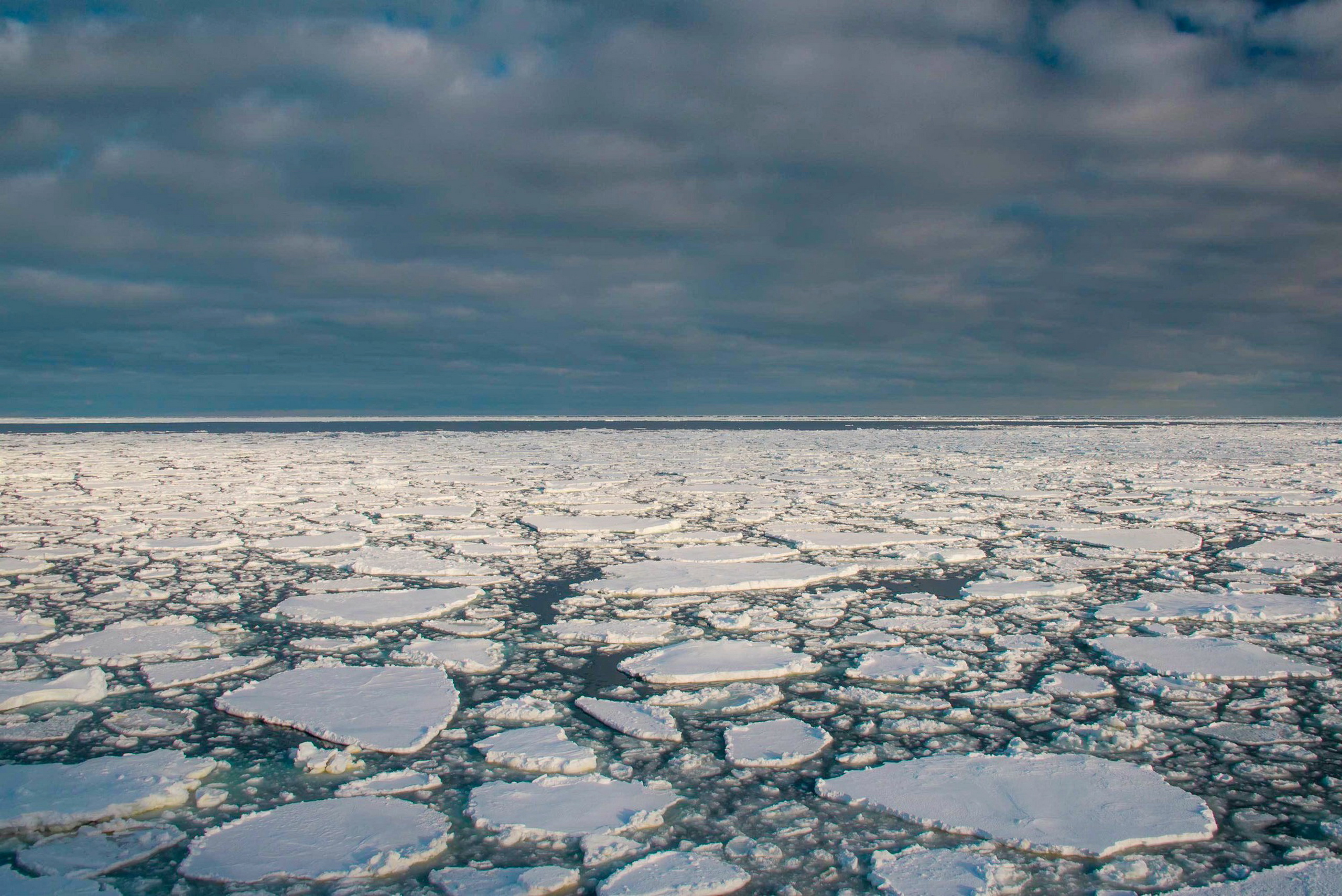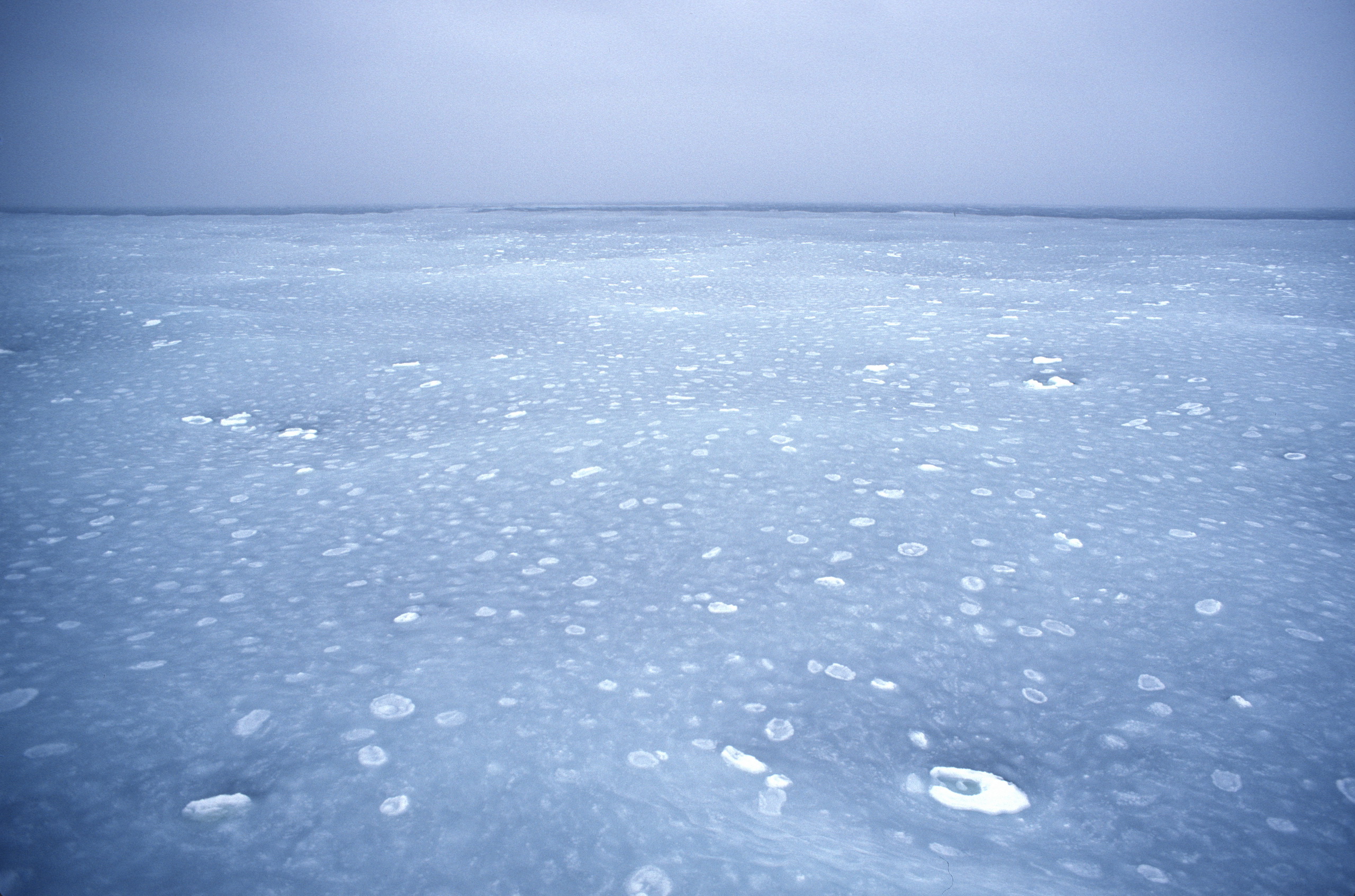
Aerial view ice growing at an ice edge, with light snow cover. Photo: Glenn Jacobson
What is Antarctic sea ice and why is it important?
Antarctic sea ice is a vast, dynamic layer of largely frozen seawater that forms around Antarctica each autumn and winter. Only a small amount of sea ice in the Southern Ocean survives the summer to become second year as the next ice-growth season commences. Sea ice significantly impacts the global climate system as it acts as a barrier between the ocean and atmosphere, influencing heat, mass, and momentum transfer. This strongly affects global ocean circulation, atmospheric circulation patterns and albedo. Sea ice also plays a crucial role in marine ecosystems, providing a habitat and ecosystem functions for a range of species, including algae, krill, and larger animals like seals, penguins, and whales.
How does Antarctic sea ice form?
Thermodynamic growth of sea ice commences as the surface water in the Southern Ocean cools during austral autumn and winter. As temperatures drop below the freezing point of seawater (-1.86°C), sea-ice crystals called frazil ice form. These crystals accumulate and consolidate, eventually forming a continuous, thin sheet of ice called nilas. Further freezing thickens the ice. Under quiescent conditions this thickens into level first year ice. However, under the influence of wind or waves, the thin nilas tends to raft, i.e., thin sea-ice layers slide over the top of each other in a process called (finger) rafting. Slightly thicker young grey sea ice tends to break into small disks, called pancake ice. As these grow into sea-ice floes, they collide with each other, leading to ridging, further contributing to ice thickness.

Cemented pancake ice. Photo: Eric Woehler

Snow covered ice floes in loose pack-ice. Photo: Dave Allen
What is the difference between landfast ice and pack ice?
Landfast ice is attached to the Antarctic coast, glacial ice tongues/shelves, islands or icebergs, and remains more or less immobile over extended time to form a continuous sea-ice sheet. In contrast, pack ice, which constitutes the majority of Antarctic sea ice, floats freely (unless under internal pressure during convergent conditions) and moves in response to wind stress, ocean currents and tides. Pack ice is characterized by a diverse range of floe sizes, ages, thicknesses, and concentrations, with open water leads frequently appearing between the floes.
What is the significance of polynyas in the Antarctic sea ice zone?
Polynyas are areas of open water or new thin ice that persist within the sea ice where based on atmospheric thermodynamic conditions a substantial sea-ice cover is expected. They play a critical role in the Antarctic ecosystem and oceanographic processes. Polynyas act as "sea-ice factories," as the exposed water readily loses heat to the atmosphere, promoting rapid sea-ice formation and influencing water mass modification through brine rejection, hence increasing the density of the underlying ocean water. The increased salinity drives bottom-water formation and influences oceanic circulation patterns. Furthermore, polynyas serve as vital feeding grounds for marine life, as they allow for sunlight penetration and nutrient upwelling.

Shuga. Photo: Eric Woehler

Snow covered ice floes in loose pack-ice. Photo: Dave Allen
How does snow impact Antarctic sea ice?
Snow significantly influences the mass and energy balance of Antarctic sea ice. It acts as an insulating layer, reducing heat loss from the ocean to a cooler atmosphere. Snow also increases the albedo of sea ice, reflecting more incoming solar radiation back into space (compared to sea ice which appears grey). Hence snow drives the so-called ice-albedo feedback. Snow also slows the sea-ice melt, as incoming radiative forcing during austral spring and summer is initially expended to melt any snow sitting on top of the Antarctic sea ice. On the other hand, heavy snow accumulation may depress the sea-ice surface below the sea level. In the presence of cracks within the sea ice or warm ice which allows upward brine perculation, this may lead to flooding. Under freezing conditions, the flooded matrix will form snow ice, a process that affects the sea ice structure and its physio-chemical markers as well as its signal across the electromagnetic spectrum, with consequences for many remote-sensing techniques.
What are the main processes driving variations in Antarctic sea ice extent?
Antarctic sea-ice extent undergoes a large seasonal cycle. In addition it exhibits high regional and short-term variability as it is influenced by a complex interplay of atmospheric and oceanic factors. Wind stress or ocean meanders may push the equatorward sea-ice edge further out, expanding the sea-ice covered area, or, conversely, compact the sea ice towards the south, leading to a reduced sea-ice extent. Air and ocean temperatures directly affect ice formation and melt rates. Ocean currents, waves and tides all play a role in transporting heat and influencing the distribution and movement of sea-ice floes. Additionally, changes in freshwater input near the Antarctic coast from melting glaciers and ice shelves may impact the persistence and formation of sea ice.

Shuga. Photo: Eric Woehler

Snow covered ice floes in loose pack-ice. Photo: Dave Allen
How is Antarctic sea ice studied and monitored?
Nowadays scientists try to utilize a multidisciplinary approach to observe and study Antarctic sea ice. Satellite remote sensing provides continuous, large-scale observations with sufficient repeat passes to derive sea-ice concentration (and hence sea-ice extent), and movement. Marine-science expeditions allow for in situ measurements of sea-ice and snow thickness, and a range of physical and biogeochemical properties. Automated instruments like drifting buoys and upward-looking sonar may collect invaluable data on sea-ice drift, deformation, and thickness variations over time. These observations, combined with numerical modeling efforts, contribute to a better understanding of sea-ice processes and their role in the climate- and ecosystem.
